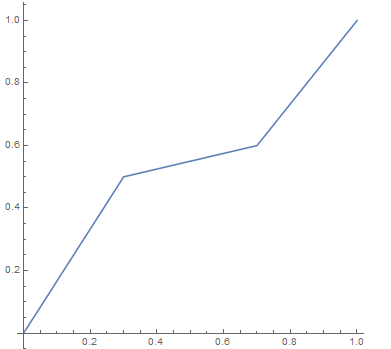First of all, let us formally interpret the question, as follows:
Take any $s$ and $t$ in $(0,1)$. Let $CI_{s,t}$ be the set of all continuous strictly increasing functions $g\colon[0,1]\to[0,1]$. Let $G_{s,t}$ be the set of all functions $g\in CI_{s,t}$ such that the set $$E_{s,t}(g):=\{x\in[0,1-s]\colon g(x+s)-g(x)<t\}$$ is nonempty. Do there exist sequences $(x_j)_{j=1}^\infty$ and $(y_j)_{j=1}^\infty$ in $[0,1]$ such that for any $g\in CI_{s,t}$ there is a natural $n$ such that the following implication holds: If for some function $h\in CI_{s,t}$ and for all $j\in[n]:=\{1,\dots,n\}$ we have $h(x_j)=g(x_j)$ and $h^{-1}(y_j)=g^{-1}(y_j)$, then
(i) if $g\in G_{s,t}$ then ($h\in G_{s,t}$ and) for some $k\in[n]$ we have $x_k\in E_{s,t}(h)$;
(ii) if $g\notin G_{s,t}$ then $h\notin G_{s,t}$.
The answer is now no, in general.
Indeed, take any $s,t$ such that $0<t<s<1$. Take any sequences $(x_j)_{j=1}^\infty$ and $(y_j)_{j=1}^\infty$ in $[0,1]$. Take any natural $n$.
Consider the set $P_{s,t}$ of all pairs $(a,b)$ such that $$0<a<a+s<1\ \&\ 0<b<b+t<1\ \&\ \min\Big(\frac{b}{a},\frac{1-b-t}{1-a-s}\Big)>\frac{t}{s}.$$ The set $P_{s,t}$ is nonempty and open; in fact, $$(a,b)\in P_{s,t}\iff \Big(0<a<1-s\ \&\ \frac{a t}{s}<b<\frac{a t+s-t}{s}\Big).$$
Take now any pair $(a,b)\in P_{s,t}$ such that $a\notin\big\{x_j\colon j\in[n]:=\{1,\dots,n\}\big\}$ and $b\notin\{y_j\colon j\in[n]\}$; such a pair $(a,b)$ exists, since $P_{s,t}$ is nonempty and open.
Next, let $g=g_{a,b}=g_{s,t,a,b}$ be the function whose graph is the union of the straight line segments successively connecting the points $(0,0),(a,b),(a+s,b+t),(1,1)$. Then $g\in CI_{s,t}\setminus G_{s,t}$. The graph of $g$ for $a=3/10,b=5/10,s=4/10,t=1/10$ is shown below.
Let $$x_{n,a}:=\min\{x_j\colon j\in[n],x_j>a\},\quad x_{n,a}^-:=\max\{x_j\colon j\in[n],x_j<a\},\quad y_{n,b}:=\min\{y_j\colon j\in[n],y_j>b\}.$$ Then $x_{n,a}^-<a<x_{n,a}$ and $y_{n,b}>b$. Since $g$ is strictly increasing, there is some $c$ such that $$b=g(a)<c<\min[g(x_{n,a}),y_{n,a}].$$ For such $c$ and all $x\in[0,1]$, let $h$ be the function whose graph is the union of the straight line segments successively connecting the points $(0,0),(x_{n,a}^-,g(x_{n,a}^-)),(a,c),(x_{n,a},g(x_{n,a})),(a+s,b+t),(1,1)$. Then $h(x_j)=g(x_j)$ and $h^{-1}(y_j)=g^{-1}(y_j)$ for all $j\in[n]$. However, $h(a+s)-h(a)=g(a+s)-c<g(a+s)-g(a)=t$, so that $h\in G_{s,t}$, whereas $g\notin G_{s,t}$. Thus, conclusion (ii) of the implication in the highlighted formalization of the question fails to hold. $\Box$

